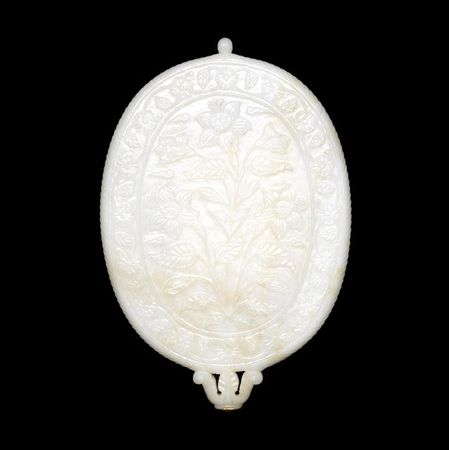13 avril 2012
Jade mirror once owned by Indian and Danish royalty for sale at Bonhams
A Mughal gem-set gold-mounted jade Mirror. Northern India, 18th Century. Photo Bonhams
LONDON.- An object that once reflected Indian perfection, a jade backed mirror, the property of a Mughal Princess, or Maharanee, is one of many fascinating items in Bonhams sale of Indian and Islamic Art on April 24th in New Bond Street.
This lovely oval carved work of art in white jade has passed through the hands of two royal houses – Indian and later Danish. It is estimated to sell for £40,000 to £60,000.
Mirrors were used by courtiers, courtesans and royals alike. Miniature paintings of maidens looking at their own reflection while being perfumed and groomed are numerous and reflect the highly valued standards of beauty and personal care at the court. Alice Bailey, Head of Islamic and Indian Art comments, “Jade carving at the Mughal court was of superior craftsmanship and pieces of this quality are highly sought after. Chinese jade carvings have topped auction estimates in recent years and fine works of Indian jades are expected to do the same.”
The 18th century Mughal gem-set gold-mounted jade Mirror is from Northern India. It is oval, with the top a carved knop in the form of a bud, the base with short handle in the form of a three leaf acanthus stem, the back carved in relief with a central medallion containing a flowering plant, within a band of flowering vine, the terminal set with a cabochon ruby, the front with bevelled mirror glass, within a gold band set with rubies and emeralds, the outer edge carved with a chevron design, in a fitted case.
The most striking and unique contribution of Mughal lapidaries to jade craftsmanship was probably the use of gold and brightly coloured gem-stones, all of which served to exhibit the lavishness of Mughal nobility for which India was renowned.
A group of Mughal mirrors attributed to the 17th Century can be found in the Salar Jung Museum, Hyderabad. The naturalistic treatment of the flowers draws comparison with the designs found on architectural panels of the 17th Century, in particular the Red Fort, the Diwani-Khas and other buildings of Shah Jahan's period. The chevron band also appears on Mughal buildings of this era. Parallels can also be found on bidri ware from the Deccan.
This lovely oval carved work of art in white jade has passed through the hands of two royal houses – Indian and later Danish. It is estimated to sell for £40,000 to £60,000.
Mirrors were used by courtiers, courtesans and royals alike. Miniature paintings of maidens looking at their own reflection while being perfumed and groomed are numerous and reflect the highly valued standards of beauty and personal care at the court. Alice Bailey, Head of Islamic and Indian Art comments, “Jade carving at the Mughal court was of superior craftsmanship and pieces of this quality are highly sought after. Chinese jade carvings have topped auction estimates in recent years and fine works of Indian jades are expected to do the same.”
The 18th century Mughal gem-set gold-mounted jade Mirror is from Northern India. It is oval, with the top a carved knop in the form of a bud, the base with short handle in the form of a three leaf acanthus stem, the back carved in relief with a central medallion containing a flowering plant, within a band of flowering vine, the terminal set with a cabochon ruby, the front with bevelled mirror glass, within a gold band set with rubies and emeralds, the outer edge carved with a chevron design, in a fitted case.
The most striking and unique contribution of Mughal lapidaries to jade craftsmanship was probably the use of gold and brightly coloured gem-stones, all of which served to exhibit the lavishness of Mughal nobility for which India was renowned.
A group of Mughal mirrors attributed to the 17th Century can be found in the Salar Jung Museum, Hyderabad. The naturalistic treatment of the flowers draws comparison with the designs found on architectural panels of the 17th Century, in particular the Red Fort, the Diwani-Khas and other buildings of Shah Jahan's period. The chevron band also appears on Mughal buildings of this era. Parallels can also be found on bidri ware from the Deccan.
Publicité
Publicité
Commentaires

/https%3A%2F%2Fprofilepics.canalblog.com%2Fprofilepics%2F1%2F0%2F100183.jpg)
/https%3A%2F%2Fstorage.canalblog.com%2F03%2F02%2F119589%2F96711876_o.jpg)
/https%3A%2F%2Fstorage.canalblog.com%2F11%2F31%2F119589%2F94773502_o.jpg)
/https%3A%2F%2Fstorage.canalblog.com%2F20%2F83%2F119589%2F94772815_o.jpg)
/https%3A%2F%2Fstorage.canalblog.com%2F26%2F72%2F119589%2F75604929_o.jpg)
/https%3A%2F%2Fstorage.canalblog.com%2F59%2F60%2F119589%2F26458628_o.jpg)




/image%2F1371349%2F20240406%2Fob_de099f_435265592-1644340289669317-27147449708.jpg)
/image%2F1371349%2F20240310%2Fob_c0e13b_431753965-1629270041176342-17091014609.jpg)
/image%2F1371349%2F20240229%2Fob_7c7d11_428701194-1625292201574126-44092414790.jpg)
/image%2F1371349%2F20240229%2Fob_b5ac39_428703110-1625267244909955-59751988979.jpg)